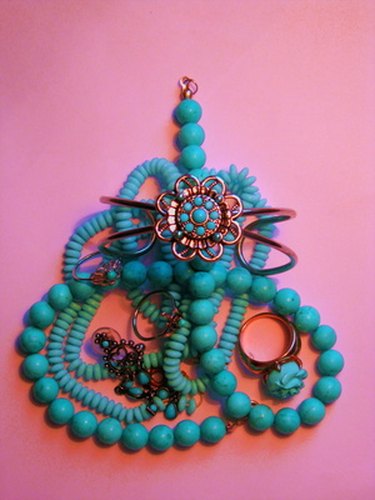Things You'll Need
Replacement turquoise cabochon or bead
Jewelry pliers
Epoxy
Bead stringing thread or wire (for turquoise bead replacement)
Craft knife (for turquoise cabochon replacement)
Jewelry wire clippers

Turquoise, a stone prized for its bright, sky-blue color, has been used as an ornament for thousands of years. However, pure turquoise is a fairly soft stone, and as such is easily chipped and broken. Chances are high that if you own a treasured piece of jewelry with turquoise cabochons or beads, you will eventually need to repair one of the turquoise components. Fortunately, this can be done relatively easily with the right tools.
Step 1
Find out if the component in need of repair is a bead or a cabochon. Cabochons are pieces of stone with a flat base that are placed in a setting.Turquoise beads can be carved in almost any shape, but will have a drilled hole for stringing the piece onto wire or beading thread.
Video of the Day
Step 2
Check the stock available at reputable jewelry suppliers for cabs or beads you can use to replace the damaged piece of turquoise. If the turquoise piece is highly unusual, you may need to substitute a complementary piece unless you can afford to have a custom piece made.
Step 3
Start repairing a broken turquoise cabochon by removing the damaged piece from the setting. For a prong-type setting, pry the prongs open with jewelry pliers and slide out the cab. For a cup-type setting, work a craft knife in between the cab and the edge of the setting. Pry around the edge of the cup until you have room to work the knife between the base of the cab and the bottom of the cup and pry the cab out of the epoxy.
Set the replacement cabochon in the setting. Use some epoxy in the bottom of a cup-type setting before placing the new cab. Use jewelry pliers to press the prongs or cup edges back over the turquoise cabochon to hold it in place.
Step 4
Start repairing a broken turquoise bead by taking the piece apart. Lay your jewelry on a work surface and cut the beading wire or thread with clippers. Slide the stringing material out of the beads, but try to keep the beads in order for easier reassembly.
Cut a new piece of stringing thread or wire, making sure to leave an extra four inches on each end for attaching clasps. Restring the beads, replacing the broken turquoise bead with the new bead. When all your beads are strung, thread the end of the string through the loop at the end of the clasp and tie a tight knot as close to the end bead as possible. Thread the other thread through the jump ring you removed from the original piece and knot the string close to the end bead. Put a drop of epoxy on each knot and let it dry. Clip the excess thread with your clippers.
Tip
For extra strength on a beaded piece you can thread the excess ends back through the beads instead of clipping them off.
Video of the Day